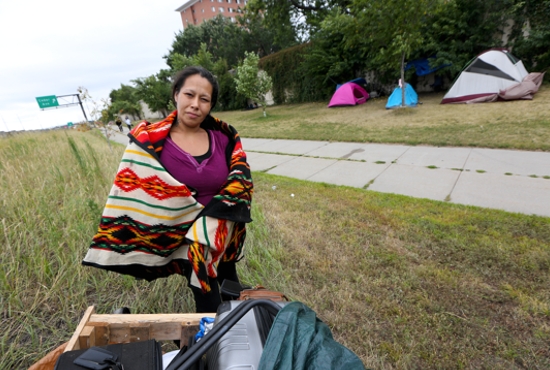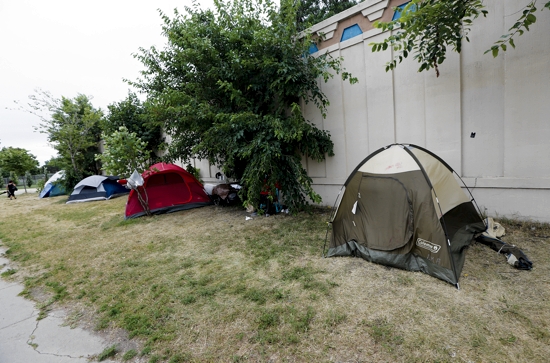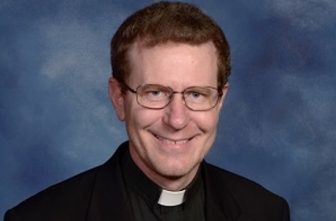
Hope LaDuke stood in the wind near a concrete sound barrier along Hiawatha Avenue in south Minneapolis Aug. 1. All of her belongings were stacked under a plastic tarp that measured roughly 5 feet square, and she pulled out a blanket that she would sleep under that night.
Homeless since February, the 31-year-old Native American woman sleeps in a makeshift shelter against the barrier, with a handful of other tents set up on either side, not far from Holy Rosary church. Six months pregnant and with a 1-year-old daughter in foster care, she’s not sure when her homelessness will end.
“Some of us have no choice,” said LaDuke, saying a death in the family, plus bills exceeding her means, put her on the streets. “There can be various reasons why bills couldn’t get paid. … Overall, it’s a tough period for some of us, and a lot of us can’t afford it.
“They say, ‘Save it for a rainy day.’ Well, sometimes for us, it rains every day.”
Activists, experts and legislators believe that permanent housing is a key factor for helping people like LaDuke, as the state nears the deadline for a lofty goal created by a 2009 Minnesota State Legislature commission: to end poverty by 2020.
Jason Adkins, executive director of the Minnesota Catholic Conference, said that poverty in Minnesota must be addressed by “the two feet of charity and justice” as Catholic social teaching describes. He explained that Catholic citizens need to encourage elected officials to enact laws that aid the poor, and Catholics have a responsibility to serve the poor directly, too.
The Joint Religious Legislative Coalition, sponsored by the Minnesota Catholic Conference and other religious public interest groups, released a report in March evaluating the progress of the 2009 legislative commission’s goals. JRLC Executive Director Anne Krisnik said it provides an overview of how the poverty landscape has improved, and the considerable work that remains.
In 2009, the bipartisan Commission to End Poverty in Minnesota by 2020 identified three benchmarks in addressing poverty in Minnesota: “reducing poverty rates among racial minority groups to the national average by 2012, reducing poverty rates among children by half by 2014, and eliminating poverty by 2020.”
JRLC’s report shows that those goals haven’t been reached and that Minnesota faces a daunting task in just reducing poverty rates. It states that 533,276 Minnesotans live below the federal poverty threshold. That includes 160,626 children, meaning 12.7 percent of Minnesota children are poor. Ten percent of Minnesota households “are impacted by hunger,” according to the report. Meanwhile, 18.3 percent of people with disabilities live in poverty.
“As we approach 2020, Minnesota needs to renew its commitment to meeting these benchmarks and to implementing recommendations of the Commissions,” the JRLC document stated.
The JRLC noted some signs of improvement, including lower housing and homelessness rates. Homelessness and affordable housing, however, continue to persist as major problems, as leaders of Catholic Charities of St. Paul and Minneapolis and CommonBond have observed in their work.
Tim Marx, president and CEO of Catholic Charities, has been on a mission for years to improve opportunities for the homeless. The Twin Cities nonprofit has been expanding its services in downtown St. Paul in recent years to replace an overcrowded Dorothy Day Center, which has long served as an overnight homeless shelter. Last year, Catholic Charities replaced the Dorothy Day Center with a larger homeless shelter, Higher Ground St. Paul, and is finishing the adjacent Opportunity Center, which will provide services to help the homeless.
CommonBond Communities, a Catholic-founded nonprofit in St. Paul, has expanded the number of its low-income properties around Minnesota and western Wisconsin. But Derek Madsen, CommonBond’s executive vice president of resource development, said they “can’t build our way out of the problem.”
Adkins observed that the housing problem trickles down from the state to city level, as many communities have regulations that lead to raising home and rental prices. Krisnik said rental property developers have added to the problem by upgrading properties and pricing out low-income renters.
The JRLC report noted some improvements in the housing situation. The 0.2 percent foreclosure rate in 2017 was the lowest in the past 10 years. Veterans’ homelessness also declined 14 percent from 2012 to 2015, and the graduation rate of homeless students increased 10 percent.
Meanwhile, renter demographics have been on the radar of both CommonBond and Catholic Charities. Madsen noted high percentages of people of color renting in comparison to whites.
“We have to recognize that racism, the racial divide, … is a significant subtext to poverty and homelessness,” Marx said.

Marx also said that facing the housing gap will help alleviate poverty significantly, as housing persists as a central issue of poverty around which the other issues revolve. A safe place to live helps people’s mental and physical health, as well as the ability to get an education and employment, he said.
Krisnik said that not all organizations addressing poverty agree that housing is the core issue. The complexity of the needs and solutions is part of what makes poverty challenging to tackle, she said.
Marx said mental health and substance abuse play a big role in people remaining homeless, and Catholic Charities works to address this need with counseling services. Adkins said mental health and substance abuse need more attention from elected officials.
Education is a major issue surrounding poverty, Adkins said, as the achievement gap between white and minority students, and high-income and low-income students, remains wide. In 2017, MCC advocated for school choice policy that would help low-income families afford the best school for their child. He said that school choice has been perceived as a “middle-class virtue,” but that it benefits students of all social classes.
The legislative commission identified education as a major area of concern, and the JRLC reported some progress, such as a 7 percent increase in students receiving free and reduced lunch at schools. The report also noted improvements in access to early childhood education, such as more funding for in-home Pre-K programs, in which an educator visits the home to teach the children and follow up with observation of the family.
Krisnik said suitable childcare remains a big obstacle for many single working parents, especially in rural areas. It makes it harder for some people to find adequate work, or the cost of childcare is too high in comparison to their wages, she said.
Rural poverty has been a less-talked-about problem around Minnesota, Adkins said, but some Catholic parishes have outreaches addressing it.
Joyce Hackworth, a volunteer with the St. Vincent de Paul Society in St. Michael, sees poverty regularly in Wright County, west of the Twin Cities. St. Vincent de Paul Society volunteers meet with the poor and provide material and financial need on a case-by-case basis. Hackworth also has seen people holding signs outside of the Catholic parishes in the area, requesting help. “It’s sad to see people in that state,” she said, adding that many can’t afford a place to live.
On the outskirts of the metro area, St. Genevieve in Centerville recently worked with St. Andrew’s Lutheran Church in Mahtomedi to open a homeless shelter in Hugo at the former St. John the Baptist rectory. The shelter can house up to 16 people per night.
“Homelessness in the more rural areas just looks different, too,” said Julie McCarthy, a parishioner of St. Genevieve who volunteers with the shelter. “Families might get by camping or sleeping at a rest stop. There are laundromats that are open 24 hours and it’s not uncommon to see a motor home parked overnight in a Walmart.”
Rural or urban, job creation remains a key to alleviating poverty, as the 2009 legislative coalition indicated. Catholic Studies professor Robert Kennedy of the University of St. Thomas in St. Paul, an expert on Catholic social teaching, said improved work opportunities help alleviate poverty, but helping people become qualified employees instead of increasing job availability helps much more.
He also noted that increasing the minimum wage, a topic addressed in the 2009 legislative commission’s final report, has not been shown to effectively resolve poverty. Instead, it leads to many employers cutting jobs to boost employee pay. However, the Church teaches that employers have an obligation to pay employees a livable wage.
Jessica Webster, an attorney with Mid-Minnesota Legal Aid, a Minneapolis nonprofit law firm that helps vulnerable citizens, said hunger and food insecurity can’t be overlooked in addressing poverty. She said if the Supplemental Nutrition Assistance Program receives the federal cuts anticipated in President Donald Trump’s 2019 budget proposal, it would affect tens of thousands of Minnesotans, and food shelves wouldn’t be able to make up the difference. She added that food insecurity feeds into the housing problem, as people in poverty get caught between buying food or paying rent.
Poverty wasn’t clearly defined by the 2009 legislative coalition, Kennedy said, noting a discrepancy between the Federal income threshold for poverty and the National Academy of Sciences’ measures for poverty. He also said that poverty really is understood in relation to a country’s wealth, and through that lens, the U.S. experiences relatively little poverty when compared to other countries.
Kennedy said that the Church calls individuals to do what they can to meet the immediate needs of the poor people they encounter. Adkins offered Pope Francis’ vision as a solution: fostering encounter in a segregated and isolated society.
Going to the voting booth and engaging legislators also make a difference, Krisnik said, as leaders on both sides of the aisle care about poverty. However, a bipartisan consensus on how to address it needs to grow, she said.
“We want to make sure that people across the state have information on challenges people in poverty face, and some possible ideas, so they can have good, meaningful conversations with candidates for office,” Krisnik said.




